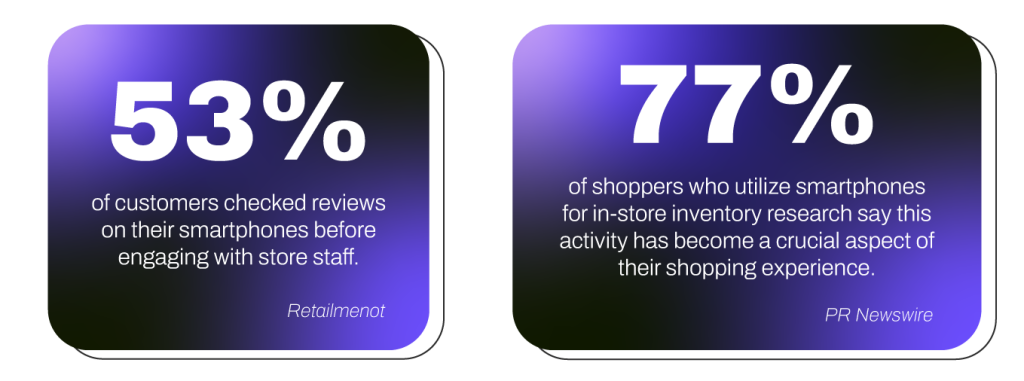Omnichannel Experience: The Art of Turning Your Channels Into Sales Channels
The Definitive Guide For Building Seamless Omnichannel Experiences
“Omnichannel Experience” is a term that has been mainstream for some time now. It isn’t a new concept, and no recent advancements have fundamentally changed how companies execute omnichannel strategies.
But despite that fact, only 11% of organizations claim to have a sophisticated omnichannel implementation, and if you’re not one of those companies, that fact should worry you.
Omnichannel experiences are going to be a crucial focal point for businesses in upcoming years and could be a serious differentiating factor for your company. In this article, we’ll explore everything you need to know about using omnichannel experiences to turn all of your channels into sales channels.
First things first, what is an Omnichannel Experience?
An Omnichannel experience provides customers with a fluid and continuous user journey across all of a company’s channels. It requires all of a company’s touchpoints to be integrated and connected.
That means that no matter where a customer might interact with your brand, they are provided with a homogeneous experience that allows them to swap over from channel to channel with ease.
Customers should be able to go through a series of channels, from social media and SMS to the company’s website and even in person, all while feeling that their interactions in one channel have somehow advanced their journey within the others.
What are the differences between Omnichannel and Multichannel?
You can think of Omnichannel and Multichannel in the same way you do squares and rectangles. An omnichannel experience is a multichannel experience, but a multichannel experience isn’t an omnichannel experience.
*For those of you who aren’t geometry teachers:
A rectangle is a four-sided shape with four 90-degree angles. A square is defined as a special rectangle where all four sides have the same length. So a square is a rectangle, but a rectangle isn’t necessarily a square.
A multichannel strategy allows customers to access multiple communication channels that aren’t necessarily synchronized or integrated. For example, a restaurant with a phone number and a website counts as having a multichannel strategy.
Only when these channels are seamlessly integrated can it be considered an omnichannel experience.
The State of Omnichannel In the U.S.
One of the most important data points you need to consider when evaluating the effectiveness of a particular strategy is the context in which it will operate, and this particular context presents us with a mobile and online-heavy customer preference.
Predictions indicate that mobile commerce (“m-commerce”) will constitute 40.4% of total e-commerce sales by 2024, and by 2025, mobile sales are expected to represent 10.4% of all retail transactions.
While you might think that this means retailers should be prioritizing their mobile channels, that won’t be enough to complete a sale. Retailers need to have their mobile channels integrated into their other touchpoints because customers use their mobile devices while engaging with other points of sale.
Just take a look at the numbers:

A customer-centric omnichannel experience prioritizes seamless transitions between brand touchpoints for swift and effortless purchases. With consumers becoming more and more tech-savvy and discerning, retailers are going to have to put even more effort into providing seamless experiences between sales channels
Why Is Omnichannel Better? The Benefits Of Creating Omnichannel Experiences For Your Customers
Before we get into how to create a robust omnichannel experience, we need to understand why this kind of strategy is beneficial for retailers. Let’s dive into a few benefits that providing a comprehensive omnichannel experience can provide retailers.

Facilitated user experience
→ An overwhelming 89% of customers express frustration when they have to explain their issues to various customer service representatives repeatedly. (Sprinklr)
→ When faced with multiple negative experiences, approximately 80% of customers prefer choosing a different company for their purchases instead of remaining loyal to the same one. (Helpscout)
→ Despite the rise of online shopping, 55% of consumers still find pleasure in visiting physical stores to physically interact with and examine products. Their in-store encounters often influence their ultimate purchasing decisions, even if the actual purchase is made online. (Viden)
Customer Loyalty
→ Positive customer service experiences lead to an 89% increase in the likelihood that customers will choose to make repeat purchases from the same company. (Helpscout)

→ Companies implementing robust omnichannel customer engagement strategies, on average, manage to retain 89% of their customers. In contrast, those with weak omnichannel approaches struggle with a customer retention rate of only 33%. (Invesp CRO)

Increased sales and profit
→ Brands excelling in omnichannel customer engagement experience a 9.5% annual revenue increase, compared to 3.4% for those employing poor omnichannel strategies. (Shopify)
→ Although omnichannel customers constitute only 7% of the total customer base, they contribute to 27% of all sales. (Digizuite)
Target’s findings indicate that customers engaging with multiple channels spend four times more than in-store customers and ten times more than those who exclusively shop online.
→ Research indicates that well-established omnichannel brands experience an annual decrease of 7.5% in the cost per contact, showcasing the efficiency of their customer engagement practices. (Shopify)
Higher purchase frequency
→ Marketers have discovered that utilizing three or more channels in a campaign can result in a 287% higher purchase rate compared to single-channel campaigns. Additionally, omnichannel experiences lead to a 250% increase in customer purchase frequency and a 13% growth in the average order size. (Omnisend)

Five Factors That Influence The Result of Your Omnichannel Strategy
There are several key factors that can significantly impact the success and effectiveness of your omnichannel experience. Understanding and leveraging these factors is crucial for creating a seamless and customer-centric omnichannel approach.
Your Social Media Channels
Social media platforms play a pivotal role in shaping the omnichannel experience for customers. The way your brand engages with and utilizes social media channels can influence customer perceptions, preferences, and interactions across various touchpoints.
Integration of social media into your omnichannel experience is a must, not only because social media is being used more and more for promoting products, but it can also become a major point of sale.
Social media integration can enhance brand visibility, foster community engagement, and provide additional avenues for customer communication.
Personalization
Personalization is becoming a crucial aspect for retailers Tailoring interactions based on customer preferences, behaviors, and history across channels helps create a more individualized and relevant customer journey.
Whether through targeted marketing messages, personalized recommendations, or adaptive user interfaces, incorporating personalization into your omnichannel strategy enhances customer experience.
We’ve actually written an article all about how hyper-personalization is changing the way consumers interact with their favorite brands. You can read all about it by clicking here.
O2O (Online to Offline) Capabilities
The seamless transition from online to offline experiences is essential in today’s omnichannel landscape. A well-executed Online to Offline (O2O) strategy ensures that customers can effortlessly move between digital channels and physical stores.
This integration provides a cohesive experience, allowing customers to research online and make purchases or seek assistance in-store, fostering a holistic and convenient journey.
To better understand how a solid O2O strategy can benefit your omnichannel experience, click here.
Strong Connection to Physical Stores
Maintaining a robust connection between digital and physical storefronts is paramount. A well-integrated omnichannel strategy acknowledges the importance of brick-and-mortar locations, ensuring that both online and offline touchpoints complement and reinforce each other.
This connection enhances brand credibility, facilitates convenient product access, and supports customer preferences for in-person interactions.
Saving Information from One Channel to Another
The ability to seamlessly save and transfer customer information between channels is a key element in creating a cohesive omnichannel experience.
When customers can effortlessly pick up where they left off, whether switching between devices or moving from online to offline, it enhances convenience and minimizes friction in the customer journey. Implementing effective data synchronization mechanisms is essential for maintaining continuity and relevance across various touchpoints.
Disney, Starbucks, Amazon & Timberland: 4 Business Cases of Good Omnichannel Experience

Disney excels in delivering a comprehensive omnichannel experience, paying meticulous attention to even the minutest details. The journey begins with the enchanting and mobile-responsive design of the entertainment giant’s website, extending to the mobile-friendly functionality of its trip-planning website—a rarity in the industry.
Upon booking a trip, the My Disney Experience tool becomes invaluable for planning the entire journey, encompassing aspects like dining choices and securing Fast Passes. While in the park, the mobile app proves indispensable for locating desired attractions and checking estimated wait times for each.
The success of Disney’s omnichannel experience lies in its provision of diverse features and tools, ensuring a truly integrated experience for customers.
Starbucks

The Starbucks rewards app stands out as a premier omnichannel experience. Customers receive a free rewards card that seamlessly integrates across various channels. Unlike conventional loyalty programs, Starbucks allows users to check and update their cards through the phone, website, in-store, or the app. Any modifications to the card or profile are instantly reflected across all channels in real-time.
The convenience extends to scenarios like standing in line for coffee with an insufficient balance. By reloading the card, the cashier is promptly notified of the update before the card is swiped.
The app’s significance in a customer’s mobile experience cannot be overstated, making Starbucks’ app a pivotal element in delivering an exceptional omnichannel experience.
Amazon

Amazon, renowned for its extensive reach, has successfully implemented an omnichannel strategy despite lacking physical stores. A key contributor to its triumph is the adept utilization of customer data, positioning the company at the forefront of this domain.
This data is employed to furnish personalized recommendations, present pertinent promotions, and facilitate straightforward customer reviews and reordering processes.
Additionally, Amazon enables customers to use a single account across different countries and sub-brands like Audible and Goodreads. Regardless of the purchase origin on Amazon.com, a unified and clearly articulated returns process is in place.
Impressively, Amazon’s ecosystem seamlessly incorporates third-party marketplace sellers who interact with customers through Amazon’s channels, ensuring a consistent brand experience. Remarkably, this is achieved without the presence of physical stores. In the realm of omnichannel retail, prioritizing smooth experiences is crucial, and Amazon excels by maintaining transparency and clarity in its communication about rules and expectations.
Timberland

Timberland enhances the customer experience in its physical stores through the adoption of near-field communication (NFC) technology. This technology, commonly used in tools like Apple Pay and Android Pay, facilitates wireless data transfer when a mobile device is tapped against a designated chip.
In contrast to its application in e-commerce, Timberland employs NFC in-store by providing customers with tablets that can be pressed against products and signage.
By pressing the tablet against the NFC chip, relevant information about the corresponding product or offer is instantly displayed. This eliminates the need for customers to seek assistance from store staff, allowing them to conveniently access details about available deals for each item.
As customers explore various products, the tablet’s personalization software utilizes their shopping history to provide tailored product suggestions, enhancing the overall shopping experience.
Omnichannel Is an Ever Changing Challenge
As new technology becomes available and Artificial Intelligence advances, there will be more and more opportunities for companies to upgrade and improve the omnichannel experience that they can provide customers.
At the end of the day, omnichannel strategies need to be as flexible as the experience they provide for users.
Digital transformation is omnichannel. Omnichannel is phygital. And digital transformation has no finishing line
We’ve touched on this in passing throughout this article, but those of you with keen eyes might have noticed it. Omnichannel is Phygital. The unification of physical and digital touchpoints is just a part of the omnichannel experience, but it is perhaps the most important part.
With brick-and-mortar on the rise and customers becoming more selective with their purchases, being able to provide a seamless transition between online research and in-store verification can mean the difference between having your customers window shop and finalizing a sale.
Phygital strategies are quickly becoming the cornerstone of successful omnichannel strategies, and that’s not by chance. In fact, we expect the term “phygital” to be one of the bug buzzwords at NRF 2024: Retail’s Big Show.
If you’re interested in what else you can expect from the largest retail convention in the world, we highly recommend you check out our article, “7 Breakthroughs You Can Expect From NRF 2024: Retail’s Big Show.”
Much like any form of digital transformation, creating a proper omnichannel experience has no finish line. The goal is continuous improvement, and that’s something MJV can help you with. If you’re looking to integrate your touchpoints and create a true omnichannel experience for your customers, why not get in touch with one of our consultants?
Remember, you don’t have to go it alone.
Back




